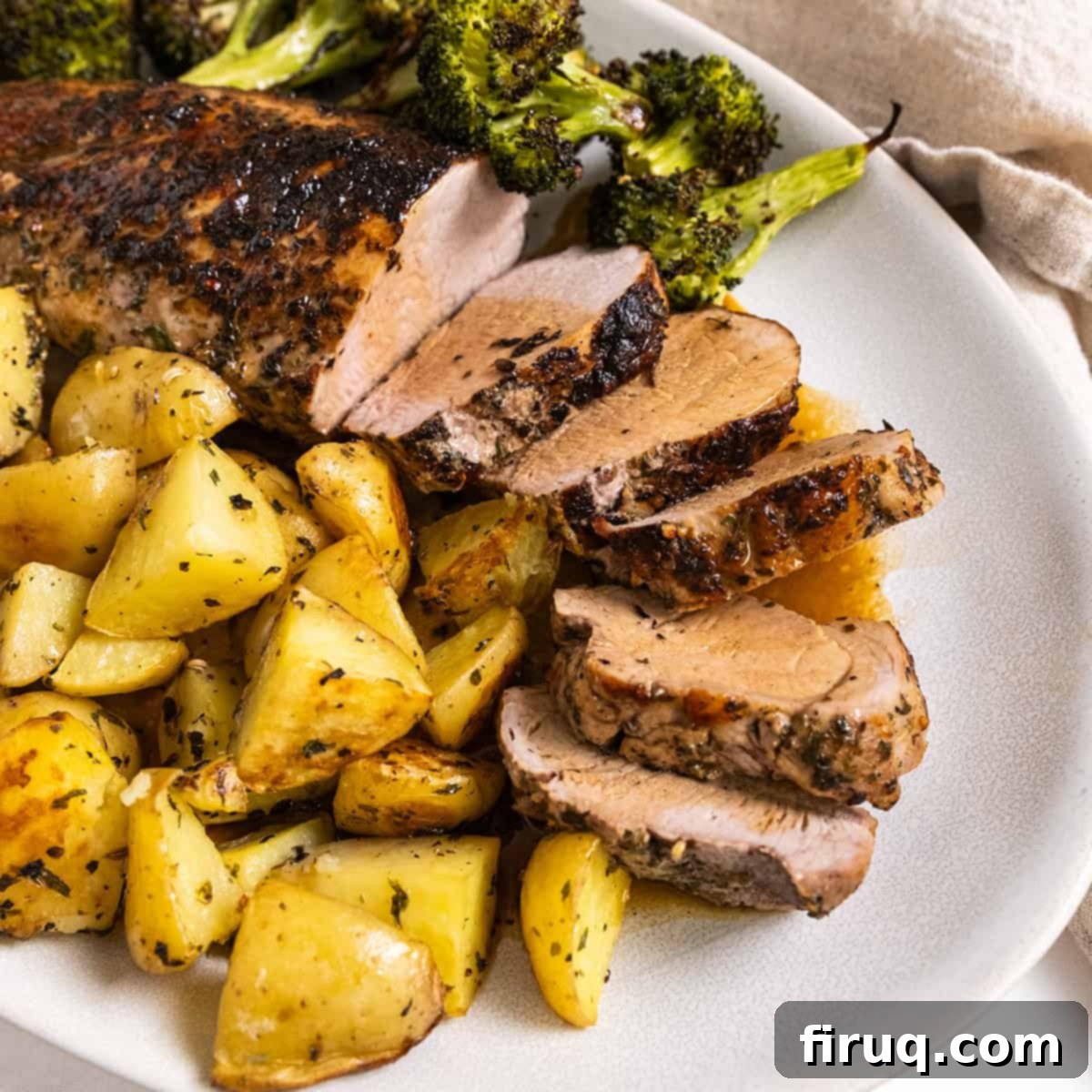Easy Italian Cast Iron Pork Tenderloin: Quick Weeknight Dinner with Garlic Butter Wine Sauce
Discover the secret to a perfectly tender and incredibly moist Italian Cast Iron Pork Tenderloin that will become a staple in your family’s dinner rotation. This recipe is designed for busy weeknights, coming together in under 30 minutes, yet delivering a gourmet experience. Each succulent slice of pork is beautifully seared to perfection in a cast iron pan, then oven-roasted to retain its juicy interior, and finally enveloped in a simple yet sensational garlic butter wine sauce that will have everyone asking for seconds. Get ready to elevate your weeknight meals with minimal effort and maximum flavor!
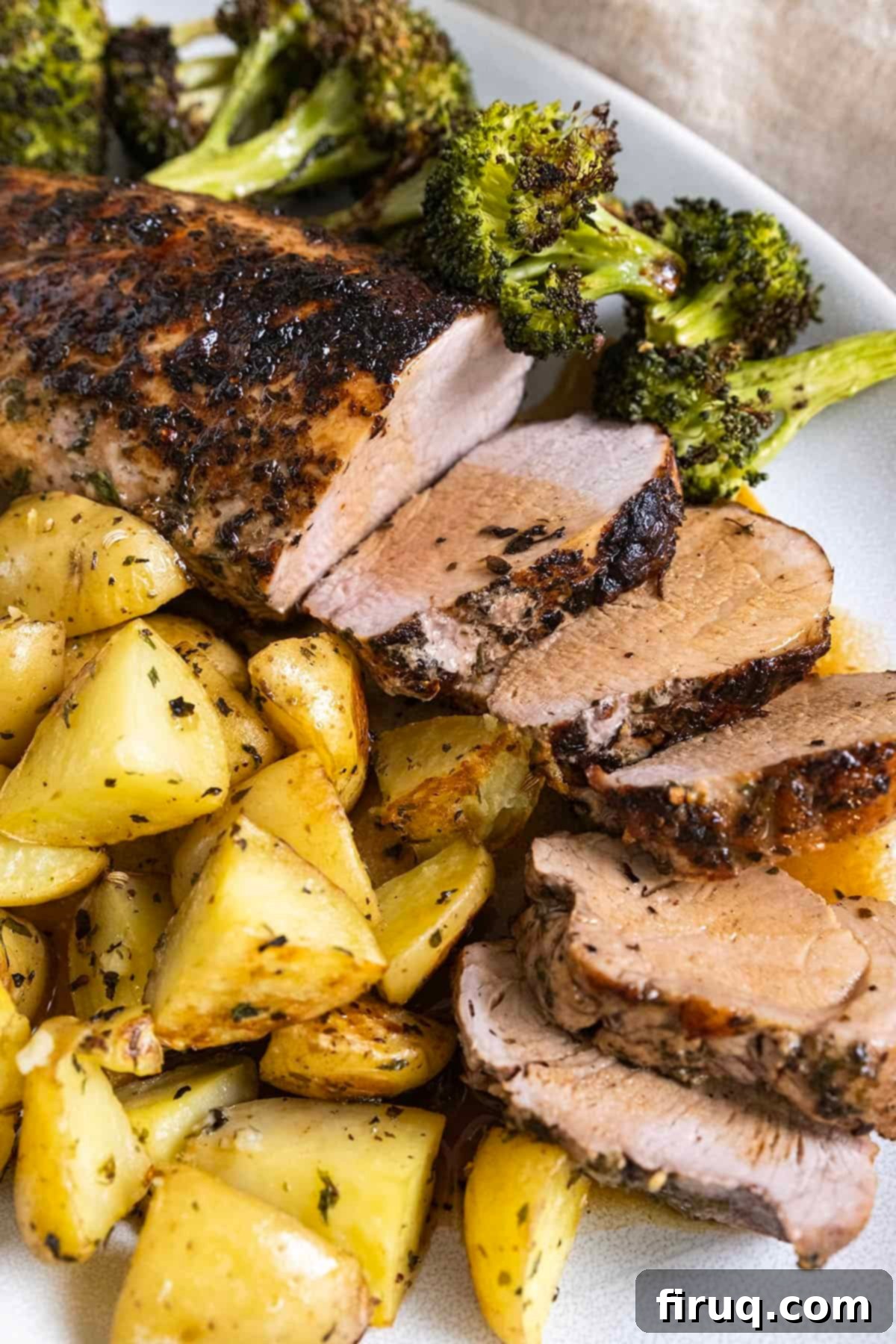
If you’re looking for more ways to enjoy succulent pork, be sure to explore our other delicious pork recipes like Classic Pork Chop Milanese or Grilled Stuffed Pork Chops! These offer fantastic variety for any occasion.
Ready to jump straight to the recipe? Use our handy navigation below:
[feast_advanced_jump_to]
Why This Italian Cast Iron Pork Tenderloin Recipe is a Must-Try
This Italian Cast Iron Pork Tenderloin isn’t just another dinner recipe; it’s a culinary revelation for busy home cooks. You absolutely should make this recipe because it ticks all the boxes for a perfect weeknight meal: it’s incredibly easy to prepare, simplifies cleanup as a one-pan dish, and offers unmatched versatility, allowing you to pair it with virtually any vegetable or starch you desire. The beauty of this method lies in its efficiency and flavor development. With a quick, high-heat sear in your trusty cast iron pan, the pork tenderloin develops a beautiful golden crust, locking in all its natural juices. From there, it effortlessly transitions directly into the oven to finish cooking, ensuring it remains wonderfully tender and moist.
But the convenience doesn’t stop there. While your perfectly cooked pork rests, you can utilize the very same pan, rich with flavorful fond, to whip up the simple yet exquisite garlic butter wine sauce. This means minimal fuss and maximum flavor, truly making it a hero dish for any occasion. Every home cook needs a repertoire of simple, reliable proteins for those hectic weeknights, and this pork tenderloin is undoubtedly one of them. For more delicious and easy meal ideas, you could also consider our Crispy Italian Chicken Cutlets, Pasta with Sausage and Broccoli Rabe, or Chicken Breast in Lemon Butter Sauce — all fantastic options for simple, satisfying weeknight dinners!
Essential Ingredients and Smart Substitutions for Your Pork Tenderloin
Crafting this delicious cast iron pork tenderloin requires just a few key ingredients, most of which you likely already have on hand. Here’s a closer look at what you’ll need and how you can adapt the recipe to your pantry:
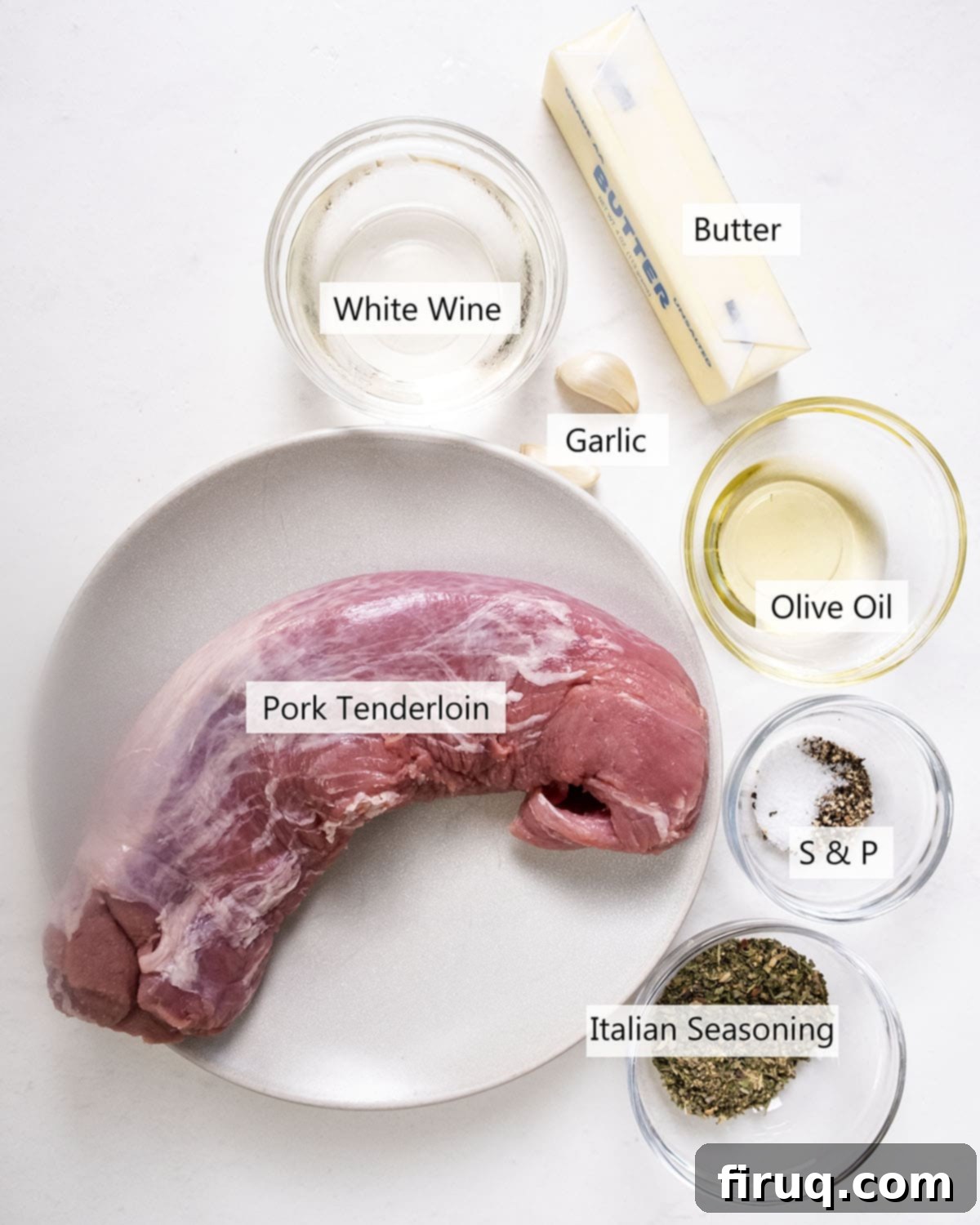
- Pork Tenderloin. For optimal results, this recipe works best with a 1.5 to 2-lb pork tenderloin. This size allows for sufficient searing and roasting time without drying out. If you opt for a smaller tenderloin, be sure to significantly decrease the time it spends in the oven to prevent overcooking. Always aim for a tenderloin that’s uniform in thickness for even cooking; if yours is thicker at one end, you can gently pound it to an even thickness or fold and tie the thinner end.
- White Wine. A dry white wine is key for the garlic butter wine sauce. I typically reach for a sauvignon blanc due to its crisp and bright notes that beautifully complement the pork. Excellent substitutes include pinot grigio or chardonnay (unoaked is preferred to avoid overpowering flavors). If you prefer not to cook with alcohol, a good quality chicken broth or vegetable broth can be used as a non-alcoholic alternative, though the flavor profile will be slightly different.
- Italian Seasoning. This blend of herbs is the backbone of the “Italian” flavor profile. You can substitute with my homemade Italian sausage seasoning for an even deeper, more authentic taste, or simply use your favorite store-bought Italian seasoning. If you only have individual dried herbs, a mix of oregano, basil, thyme, and rosemary will work wonderfully. For an extra fresh burst, consider adding a sprinkle of fresh chopped parsley or basil at the very end.
- Olive Oil. A good quality extra virgin olive oil is essential for searing the pork and forming that beautiful crust.
- Unsalted Butter. Used in the sauce, butter adds richness and a silky texture. Using unsalted butter allows you to control the seasoning precisely.
- Garlic. Freshly crushed garlic is non-negotiable for that aromatic, savory depth in the sauce. Do not use garlic powder if you can help it!
- Salt & Black Pepper. Simple yet crucial for seasoning the pork and enhancing all the other flavors. Use freshly ground black pepper for the best taste.
*Please see the recipe card below for more detailed information on exact measurements and ingredients.
Mastering the Art of Cast Iron Pork Tenderloin: A Step-by-Step Guide
Creating this flavorful Italian Cast Iron Pork Tenderloin is a straightforward process that yields impressive results. Follow these simple steps for a truly memorable meal:
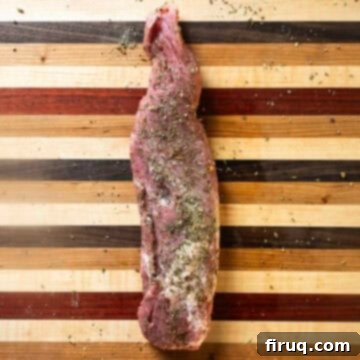
Step 1: Prepare and Season the Pork. Begin by preheating your oven to 375℉ (190°C). It’s crucial to remove the pork tenderloin from the refrigerator at least 30 minutes before cooking. This allows the meat to come closer to room temperature, ensuring more even cooking and preventing the outside from drying out while the inside struggles to cook. Pat the pork thoroughly dry with paper towels – this step is vital for achieving a beautiful, crisp sear. Then, generously season the entire surface of the tenderloin with Italian seasoning, salt, and freshly ground black pepper.
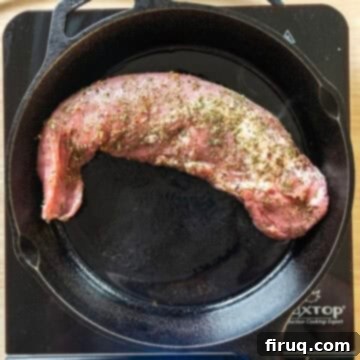
Step 2: Sear for a Perfect Crust. Place your cast iron pan on the stovetop and heat it to medium-high. Once hot, add the olive oil, swirling to coat the bottom of the pan. Carefully place the seasoned pork tenderloin into the hot pan. Sear the pork on each side for a vigorous 60-90 seconds. The goal here is to achieve a deep golden-brown crust, which adds incredible flavor and texture to the finished dish. Don’t crowd the pan; ensure the pork has direct contact with the hot surface.
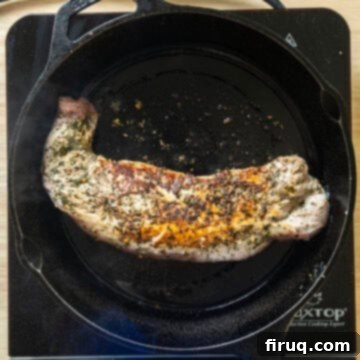
Step 3: Oven Roasting to Finish. Once seared on all sides, immediately transfer the cast iron pan (with the pork tenderloin still inside) into the preheated oven. Bake for 15-20 minutes. The cooking time will vary based on the thickness of your tenderloin and your oven. The most accurate way to determine doneness is by using an instant-read meat thermometer. You’re aiming for an internal temperature of 140℉ (60°C) for medium-rare. Remember that the temperature will rise slightly as the meat rests.

Step 4: Rest and Slice. This step is non-negotiable for juicy pork! Immediately remove the tenderloin from the cast iron pan and transfer it to a clean cutting board. Tent it loosely with foil and allow it to rest for a full 10 minutes. This resting period allows the juices to redistribute throughout the meat, ensuring every bite is succulent and flavorful. After resting, slice the tenderloin into ¾ inch (about 2 cm) thick medallions. This thickness is perfect for showcasing its tenderness and absorbing the delicious sauce.
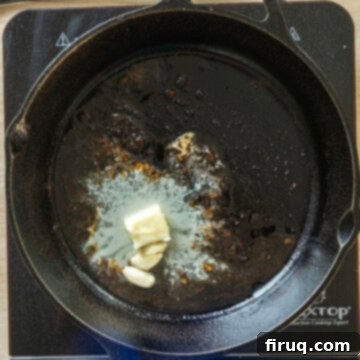
Step 5: Craft the Garlic Butter Wine Sauce. While the pork rests, place the same cast iron pan back on the stovetop over medium-low heat. The pan should have delicious brown bits (fond) stuck to the bottom – this is pure flavor! Add the unsalted butter and crushed garlic to the pan. Sauté gently until the butter melts and foams, and the garlic becomes fragrant (about 30-60 seconds), being careful not to burn it. Once the butter finishes foaming, pour in the white wine. Deglaze the pan by scraping up all those flavorful brown bits from the bottom with a wooden spoon or spatula. This will infuse the sauce with incredible depth.
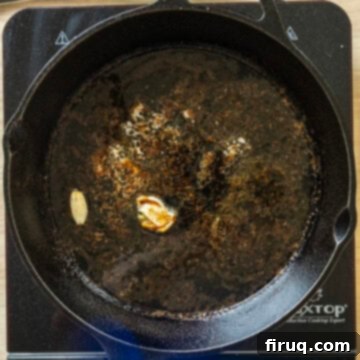
Step 6: Reduce and Serve. Bring the wine sauce to a gentle simmer and allow it to reduce by half. This process concentrates the flavors and thickens the sauce slightly. It should take about 3-5 minutes. Taste and adjust seasoning if needed. Once reduced, remove the pan from the heat. Arrange your sliced pork tenderloin on a serving platter or individual plates, then generously pour the rich garlic butter wine sauce over the top. Serve immediately and prepare for rave reviews!
This exquisite Italian Cast Iron Pork Tenderloin pairs perfectly with a variety of side dishes. For an authentic Italian experience, serve it alongside our vibrant Italian Lacinato Kale Recipe (Tuscan) and either a creamy Zucchini Risotto or a comforting Creamy Garlic Mushroom Pasta!
If you’re a devoted fan of pork recipes and seeking more inspiration, don’t miss our tantalizing Bourbon Peach Glazed Pork Chops.
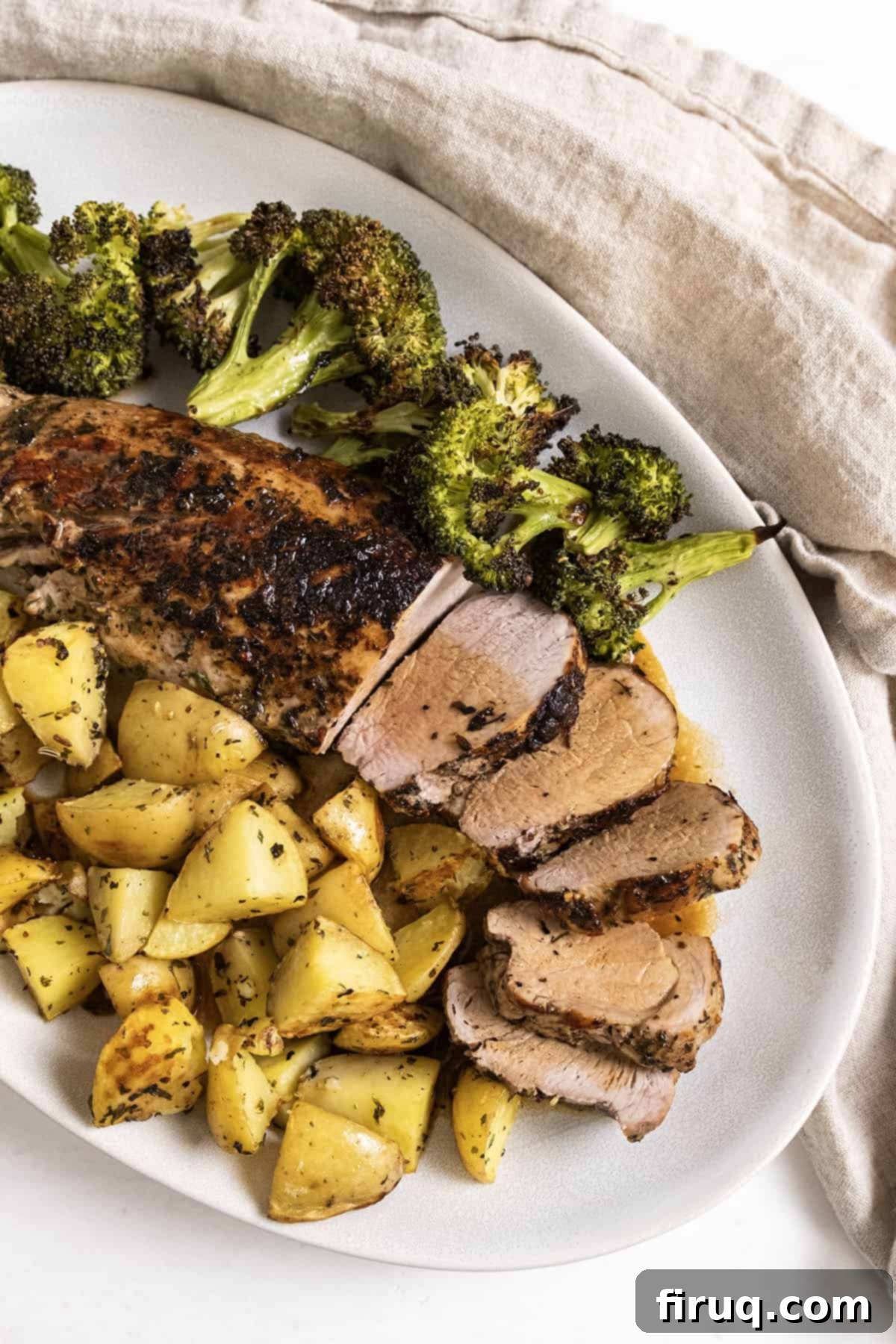
Pro-Tips for a Perfect Pork Tenderloin Every Time
Achieving a restaurant-quality pork tenderloin at home is easier than you think with these expert tips:
- Bring the Pork to Room Temperature: This is a game-changer! Take the pork tenderloin out of the refrigerator for 15-30 minutes before you plan to cook it. Allowing it to come closer to room temperature ensures that the meat cooks more evenly from edge to center. This will help keep the pork incredibly tender and moist, preventing the outer layers from drying out while the interior struggles to reach the correct temperature in the oven.
- Always Dry the Pork Thoroughly: Before applying any seasoning, vigorously pat the pork dry with a paper towel. Moisture on the surface of the meat will steam rather than sear, preventing you from achieving that coveted, flavorful golden-brown crust (the Maillard reaction). A dry surface is crucial for a successful, crisp sear.
- Sear on Multiple Sides: While a pork tenderloin isn’t perfectly square, you can still maximize browning. I typically sear the pork on at least “3” sides (or even 4, rotating it gently) even though it’s a rounded shape. On the “3rd” (or final) side, I might sear for a slightly shorter duration, about 30 seconds, just to develop a little more color before transferring it to the oven. This comprehensive searing ensures a delicious crust all around, contributing significantly to the overall flavor and texture.
- Don’t Overcook: Pork tenderloin is lean and can dry out easily. Use an instant-read thermometer and aim for 140-145°F (60-63°C) for medium-rare to medium, remembering it will continue to cook a few degrees as it rests.
- Rest Your Meat: Resist the urge to slice immediately! Resting the pork for 10 minutes allows the muscle fibers to relax and reabsorb the juices, ensuring a tender and moist result.
Frequently Asked Questions About Cast Iron Pork Tenderloin
Absolutely, yes! Searing a pork tenderloin is not just recommended, it’s the best way to develop a deeply flavorful, crispy crust through the Maillard reaction. This high-heat initial step caramelizes the exterior sugars and amino acids, creating rich, complex flavors. Simultaneously, it helps to seal in the juices, ensuring the center of the tenderloin remains incredibly moist and tender during the subsequent oven roasting. It’s the critical step for achieving a perfect texture contrast.
The most highly recommended and effective method for cooking pork tenderloin is the “sear and roast” technique, as used in this recipe. First, you sear the tenderloin on the stovetop in a hot cast iron pan to develop a beautiful crust and lock in flavor. Then, you transfer it to the oven to finish cooking gently and evenly to the desired internal temperature. After roasting, it’s vital to let the tenderloin rest for at least half the time it was cooked (around 10 minutes for this recipe) to allow the juices to redistribute, resulting in exceptionally tender and juicy meat. This two-stage approach ensures both a flavorful exterior and a perfectly cooked interior.
For optimal tenderness and juiciness, pork tenderloin should be roasted to an internal temperature of 140-145°F (60-63°C), followed by a resting period. While the USDA recommends 145°F (63°C) for whole cuts of pork, cooking to 140°F and then letting it rest will allow the carryover cooking to bring it up to a safe 145°F, ensuring it remains incredibly tender and slightly pink in the center, which indicates perfect doneness. Always use an instant-read meat thermometer inserted into the thickest part of the tenderloin for accuracy. The oven temperature for roasting after searing should be between 375°F to 400°F (190-200°C).
While the best results come from cooking and serving immediately, you can season the pork tenderloin up to 24 hours in advance and store it in the refrigerator. This allows the flavors to meld beautifully. You can also prepare the garlic butter wine sauce in advance and gently reheat it before serving. However, for the best texture and juiciness, sear and roast the pork just before you plan to eat.
Store any leftover pork tenderloin and sauce in separate airtight containers in the refrigerator for up to 3-4 days. To reheat, gently warm the sliced pork in a pan over low heat with a splash of broth or water to prevent drying, or in the microwave on a low setting. Reheat the sauce separately and pour over the warmed pork. Be careful not to overcook when reheating, as this can make the pork tough.
Perfect Pairings: What to Serve with Cast Iron Pork Tenderloin
This versatile Italian Cast Iron Pork Tenderloin with its rich garlic butter wine sauce makes an ideal centerpiece for a wide array of side dishes. Here are some fantastic suggestions to complete your meal:
- Flavorful Vegetables. A robust vegetable side complements the tender pork beautifully. I particularly love to serve this with roasted broccoli, allowing its slight bitterness and crisp texture to contrast with the rich pork. Other excellent choices include our savory Sauteed Rapini with Garlic, Garlic Parmesan Green Beans for a touch of freshness and cheesy goodness, or a hearty Chopped Brussels Sprout Salad with Pancetta for a delicious textural element.
- Hearty Starches. To soak up every drop of that incredible garlic butter wine sauce, a good starch is essential. I always recommend adding a side like our perfectly crispy Crispy Garlic Parmesan Potatoes or a light and zesty Lemon Spinach Orzo. These options offer both comfort and absorbency, ensuring no flavor goes to waste. Creamy mashed potatoes or a simple rice pilaf would also be wonderful additions.
- Fresh Salads. For a lighter touch or a refreshing contrast, a crisp salad is always a welcome companion. This dish definitely goes well with a hearty Kale and Cannellini Bean Salad for a nutritional boost, or a classic Traditional Caesar Dressing tossed with crisp romaine lettuce. The bright acidity and crunch of a salad provide a lovely balance to the richness of the pork and its sauce.
Explore More Delicious Cast Iron Creations
If you love the magic of cooking with cast iron as much as we do, you’re in for a treat! Cast iron pans are incredible for developing rich flavors and achieving perfect sears. Here are some other favorite recipes that truly shine when made in cast iron:
- PERFECT Cast Iron Boneless Pork Chops
- PERFECT Cast Iron Chicken Breast
- Cast Iron Shrimp and Creamy Cilantro Lime Orzo
- Cast Iron Lemon Chicken Orzo Recipe
We absolutely love hearing from you! Please leave a comment and a star rating below in the recipe card if you try this delicious Italian Cast Iron Pork Tenderloin. Your feedback helps us grow and inspires other home cooks. Feel free to tag us on Instagram @vindelgiudice and share your culinary creations!
📖 Recipe
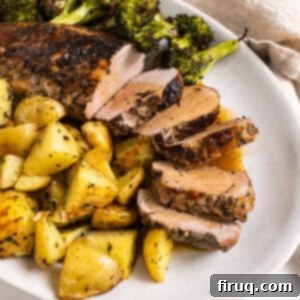
Italian Cast Iron Pork Tenderloin
Vincent DelGiudice
Pin Recipe
5 minutes
25 minutes
30 minutes
Dinner, Main Course
American, Italian
4
servings
119
kcal
Equipment
-
1 large cast iron pan
Ingredients
-
1
1.5-2lb
pork tenderloin -
2
tablespoons
Italian seasoning -
1
teaspoon
salt -
½
teaspoon
black pepper -
1
tablespoon
olive oil -
3
tablespoons
unsalted butter -
⅓
cup
dry white wine (like Sauvignon Blanc) -
2
cloves
garlic, crushed
Instructions
-
Preheat your oven to 375℉ (190°C). Take the pork tenderloin out of the fridge 30 minutes before cooking to bring it closer to room temperature for even cooking. Pat it thoroughly dry with paper towels, then generously season with Italian seasoning, salt, and pepper.
-
Heat a large cast iron pan over medium-high heat. Once hot, add the olive oil. Carefully place the seasoned pork tenderloin into the hot pan and sear on each side for 60-90 seconds until a deep golden-brown crust forms.
-
Transfer the cast iron pan (with the pork tenderloin) into the preheated oven. Bake for 15-20 minutes, or until an instant-read meat thermometer inserted into the thickest part of the tenderloin registers 140℉ (60°C).
-
Carefully remove the tenderloin from the pan and place it on a cutting board. Tent loosely with foil and let it rest for a full 10 minutes. This is crucial for keeping the pork juicy. After resting, slice the tenderloin into ¾ inch (about 2 cm) thick medallions.
-
Place the cast iron pan back on the stovetop over medium-low heat. Add the unsalted butter and crushed garlic to the pan. Sauté until the butter melts and the garlic is fragrant (about 30-60 seconds). Once the butter stops foaming, add the white wine, scraping up any browned bits from the bottom of the pan. Bring the sauce to a simmer and allow it to reduce by half, which will concentrate the flavors and thicken it slightly. Pour the delicious garlic butter wine sauce generously over the sliced pork tenderloin and serve immediately.
Notes
-
- Take the pork tenderloin out of the refrigerator for 15-30 minutes to bring it closer to room temperature. This will help keep the pork tender and moist and avoid drying it out in the oven by ensuring more even cooking.
- Dry the pork with a paper towel before seasoning. This crucial step allows for a proper sear and a beautiful, flavorful crust.
- I typically sear the pork on “3” sides (or even 4, rotating it gently) even though it’s a rounded shape. On the 3rd (or final) side, I might sear for about 30 seconds to develop additional color before placing it in the oven. This maximizes the delicious crust.
Nutrition
Calories:
119
kcal
Carbohydrates:
2
g
Protein:
0.5
g
Fat:
12
g
Saturated Fat:
6
g
Polyunsaturated Fat:
1
g
Monounsaturated Fat:
5
g
Trans Fat:
0.3
g
Cholesterol:
23
mg
Sodium:
876
mg
Potassium:
49
mg
Fiber:
1
g
Sugar:
0.1
g
Vitamin A:
305
IU
Vitamin C:
1
mg
Calcium:
47
mg
Iron:
1
mg
Tried this recipe?
We’d love for you to Leave a Review!
